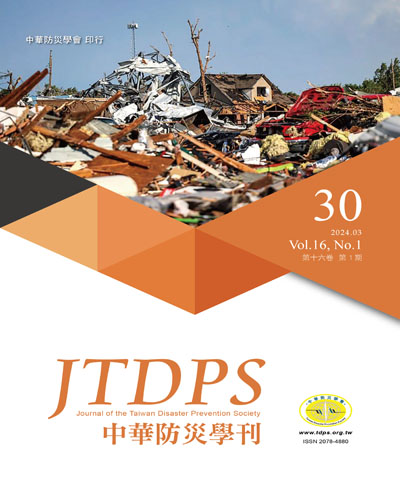
中華防災學刊/Journal of the Taiwan Disaster Prevention Society
中華防災學會,正常發行
選擇卷期
- 期刊
近幾年來大規模崩塌所衍生災害為坡地防災的重點,2009年莫拉克颱風期間,由潛在大規模崩塌轉換成劇變式山崩,在小林村造成450人傷亡的嚴重災情。如何找出台灣全島大規模崩塌潛勢區位、評估其災前災後的影響,快速地提供地表變形資訊,成為後續大規模崩塌災害防治重要的參考。過去幾年間,經濟部中央地質調查所針對莫拉克颱風受災集水區,藉由產製高精度空載光達(Airborne LiDAR)數值地形,配合同步高解析度航照影像,輔以地質資料及野外勘查,判釋出坐落於臺灣南、中、東部區共56處,具保全對象(包括聚落、水庫、道路及橋梁等)之大規模崩塌潛勢區位。然而大規模崩塌潛勢區位之變形作用極為複雜,藉此行政院農業委員會水土保持局,為持續掌握大規模崩塌潛勢區位之地表變形,首度使用日本衛星雷達影像(ALOS/PALSAR),進行大規模崩塌潛勢區位活動性之可行性評估,突顯此項技術有助於大規模崩塌災害後續防治之工作。本研究利用莫拉克風災前後日本衛星雷達影像(ALOS/PALSAR)產置崩塌區位內之地表變形量,藉此評估單一崩塌潛勢區內活動性較高之區域,將有助於後續之減災工作。
- 期刊
為瞭解降雨對不同地質條件的邊坡穩定的影響情形,本研究分別於嘉義縣阿里山公路86k+950處之崩積層邊坡、台南市南橫公路52k+150處之砂頁岩層邊坡以及高雄市藤枝林道01k+800處之頁岩層邊坡選定試驗場址作為代表,此三路段皆位於南部山區重要的交通道路上,其安全性是為用路人首要關心。本研究採集現地地層樣本進行室內試驗,以了解邊坡的地層分佈及其物理性質與力學特性,同時進行滲透試驗,了解在不同岩性之坡體的滲透性。利用地質鑽探、水位井、傾斜觀測管、地電阻建立各試驗邊坡的地層構造,並設立一長期監測系統以觀測可能滑動面深度及範圍。此外並以GEO STUDIO數值模型,依據適當的條件進行數值模擬。進而探討地下水位變動與邊坡穩定性之關係,再結合各邊坡之雨量資料紀錄以探討不同岩性邊坡之降雨量與地下水位變動之關係,最後整合三處試驗邊坡之降雨量-地下水位變動-邊坡穩定性之間的關係,為研究地區建立以降雨量為基礎的邊坡破壞預警系統。
- 期刊
元長鄉及土庫鎮等雲林縣內陸地區地層下陷主要來自深度大於150m深層土層之壓縮,約占整體下陷量的三分之二,歷年來測沉磁環之監測資料也可看出即使兩土層厚度相近,深度大於100m土層之沉陷量仍較深度100m內土層來的大,故有必要探討深層土層之壓密回脹特性。由於台78線快速道路與台灣高鐵等重大交通運輸路線位於該下陷區內,若能掌握附近地層之壓縮回脹特性,則可對雲林地區地層之沉陷行為有進一步了解。壓密試驗結果顯示,深度大於100m黏土層之壓縮指數與100m內相差1.5-2倍,砂土層雖然整體而言壓縮指數較黏土層來的小,但深度100m至300m砂土層之壓縮指數仍比100m內來的大,其中30m至100m間有一段最小值。以上結果皆與STA-9測沉磁環之監測結果相符,且雲林地區目前地層下陷主要集中於深度大於100m的土層,深度158.2m至219.5m黏土層最為嚴重,淺層土壤則因壓縮性較低,影響僅限於局部範圍。
- 期刊
在氣象局服務四十年期間,初期雖然面臨「氣象預報」工作的瓶頸,歷經外界的誤會和指責,但仍憑著一股熱忱、執著及敬業的態度,慢慢的轉進「氣象防災」,再邁向「災害防治」完全不同領域的生涯境界,最後親眼看見、親耳聽到全國同胞真正感受到氣象局以及各級政府的防救災單位,對民眾所付出的努力及關懷的讚許和肯定。尤其在遭遇各種天災地變時,民眾均能及早且主動地採取應變措施和處置作為,以減輕或避免不必要的危害,維護自己的生命財產安全,進而厚植我們的國力,心裡也感到相當的欣慰。至於負責災害防救業務的我們,在推動或執行「防災」或「災防」工作時,絕對不能無限上綱;因為以目前的科技水準,任何的「災害防救」措施及「災害防治」作為,絕對不可能讓災害所承受的「風險」降至零,這必須要對民眾講清楚、說明白,以免造成更大的誤解,甚至釀成更嚴重、更無謂的傷害,否則將得不償失
- 期刊
The article presents several online educational and informative resources such as text, graphs, videos, animations and images that deal with sustainable intensification in agriculture. Such resources can be downloaded for free by the reader, and used by the teachers with the method felt as most appropriate. According to the Food and Agriculture Organization, an estimated increase in food production from the current 8.4 to 13.5 billion tonnes a year is required in order to to satisfy the increasing world population needs. This entails important changes in both food and agriculture systems while the natural environment, already depleted in both natural resources and agricultural areas, must be protected. Several papers presented in this article deal with rice. The System of Rice Intensification (SRI) allows the farmer to achieve higher yields and more resilient plants using less water and with lower methane emissions. Whereas, rice-fish farming gives an additional yield of fish using fewer agrochemicals as compared with conventional rice farming. The article also deals with the "ecosystem services" provided by rice paddies and the importance of their conservation for the environment. The system of wheat intensification is a technique aimed at achieving high yields and resilient plants using a low input technology. Although the production method is labour-intensive, due to the additional care required in crop management, this innovative technique increases food security and net income of resource-poor farmers. Papers, videos and animations presented in this article also deal with the "conservation biological control". This technique relies on a management of the agroecosystem aimed at protecting and enhancing the natural enemies, often already present in the environment and so important in the control of pests. The paper also deals with the importance of cover crops and no-till techniques in the protection of agroecosystems and, through reduced losses of both nitrogen and phosphorus, in the conservation of aquatic ecosystems.

